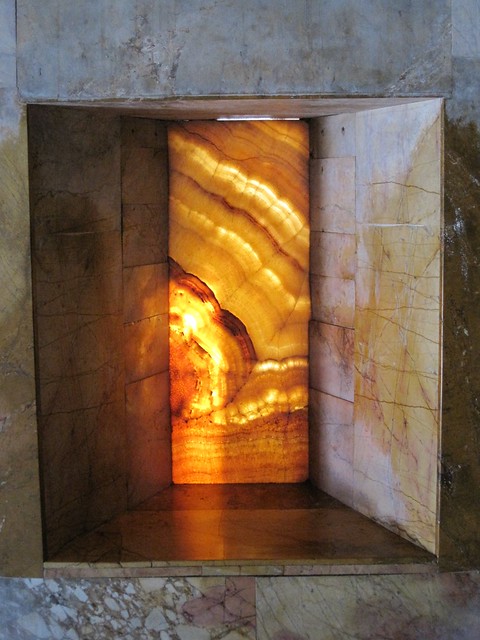With a trip to Ravenna I had the chance to visit the city and its UNESCO World Heritage for the second time; here some impressions:
Stone slices vs. painted glass
In Basilica di San Vitale and in Mausoleo di Galla Placidia the warmth and the particular tone of light is due in the first case to a layer of yellow/orange coat of paint on the window glasses, and in the second thin slices of alabaster substitute proper glass. In both monuments glass and stone are not original but have been replaced during time, however the feeling of the proper atmosphere remains.
 |
| Interior of the Mausoleum. Photo by dvdbramhall |
In recent times Sigmar Polke referred directly to this Romanesque technique in a commission he had for the Grossmünster Church in Zürich, as you can read in the official press release:
"In 2006, Sigmar Polke won the invited competition to design church windows for the Grossmünster in Zürich. Seven windows in the western part of the nave consist of sliced agate, creating brightly luminous walls of stone. The five windows to the east depict five figures from the Old Testament in stained glass."
 |
| Sigmar Polke's Agate-window. Photo by Perspectix |
"The seven windows to the west consist of sliced agate stones assembled like a mosaic, and joined with strips of lead, known as cames. Sigmar Polke draws on the custom of occasionally fitting windows with slices of stone in Romanesque church architecture of late antiquity and the early Middle Ages. This is most famously illustrated by the alabaster used in the Byzantine mausoleum of Galla Placidia in Ravenna in the fifth century. By closing off the windows and, in effect, the entire rear of the church with slices of agate stone, Polke succeeds in transforming the Grossmünster into an event of luminous colour, resulting in the seeming paradox of walls that are solid but radiantly translucent. Geologic time resonates in the images of nature within the agate stones themselves. Their intense colouring, which makes them look so contemporary, at times recalling movements of Modern Art, is, however, the consequence of the complex processes to which the stones were subjected after extraction: almost alchemical acts of applying heat, using chemical baths and adding pigments."
Alexander Brodsky, Russian artist and architect proposed in 2004 his "Vodka Ceremony Pavilion", a luminous folly comprising nothing but re-purposed windows and a few wooden braces, all whitewashed and assembled into a small hut. Built for the Art-Klyazma festival, it was equipped with only the bare essentials for its function: a small table and a pair of tin cups tethered to a basin filled with spirits." Here all window-glasses are painted in white, giving to the material a translucent quality.
Brick vs. mortar
Again in San Vitale you can note a particular way of constructing brick-walls: since under Justinian I, Eastern Roman Emperor, Byzantine culture spread significantly and Ravenna was a major pole in this sense, even building techniques were adopted from the Constantinople: there, pozzolana, a volcanic ash used by Romans to get stronger mortar, was missing, so they had to build walls with a core of abundant cement and stones, kept together by two layers of bricks, larger than Roman ones. Moreover, mortar between bricks had to be thicker, sometimes even thicker than the brick itself.
 |
| San Vitale, detail |
Sigurd Lewerentz in 1956 designed the most renowned St. Mark's Church, Björkhagen, Stockholm, in which mortar gains in thickness, giving a softer mood and avoiding monotonous walls.
 |
| St. Mark's Chirch's interior, architectu S. Lewerentz. Photo seier+seier |


No comments:
Post a Comment